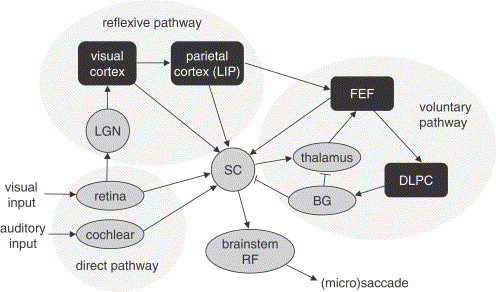Oculomotor control and visual attention
The eye movement falls into two wide classes. Gaze-stabilization movements move the lines-of-sight of the two eyes to accurately compensate for an animal's self-motion, stabilizing the visual world on Retina. Gaze-aligning movements point a section of the retina expert for high resolution at objects of interest in the visual world.
In mammals, the gaze-stabilization movements are accomplished by two partly self-governing brain systems. The vestibulo-ocular system utilizes the inertial velocity sensors attached to the skull to determine how rapidly and in what direction the head is moving and then rotates the eyes in equal and opposite amount to keep the visual world stable on the retina. The opto-kinetic systems extract information from the visual signals of the retina to determine how rapidly and in what direction to rotate the eyes to stabilize the visual world.
Gaze-aligning movement also falls into two wide classes: Saccades and smooth pursuit movements. The saccadic eye movements quickly shift the lines-of-sight of two eyes, with regard to the head, from one place in visual world to the other at rotational velocities up to 1000°/s. Smooth Pursuit eye movements rotate the eyes at a velocity and in a direction matching to those of a moving visual target, stabilizing the moving image at retina. In humans and binocular animals, a third class of vergence movements, gaze-shifting movements, operate to shift the lines-of-sight of the two eyes with regard to each other therefore both eyes can remain fixated on visual stimuli at various distances from the head.
In humans, all eye movements are rotations accomplished by merely six muscles operating in three antagonistic pairs. One pair of muscles situated on either side of each eyeball controls the horizontal orientation of each eye. The second pair controls vertical orientation and a third pair controls rotations of the eye around the line-of-sight (i.e., torsional movements). Such torsional movements are actually quite general, however usually less than 10° in amplitude.
These six muscles are controlled by three brainstem nuclei. Such nuclei hold the cell bodies for all of the motor neurons that innervate the oculomotor muscles and therefore serve as a final common path via which all eye movement control should be accomplished. The engineering models of eye and its muscles specify that motor neurons should generate two classes of muscle forces to accomplish any eye rotation: A pulsatile burst of force which regulates the velocity of an eye movement and a long-lasting increment or decrement in maintained force which, after the movement is complete, it holds the eye stationary by resisting the elasticity of the muscles that would slowly draw the eye back to a straight-ahead position. Physiological experiments have elaborated that all motor neurons participate in the generation of both of these two kinds of forces.

These two forces, in return, appear to be generated by separable neural circuits. In the 1960s it was recommended that changes to the long-lasting force needed after each eye rotation could be calculated from the velocity, or pulse, signal by the mathematical operation of integration. In 1980s the lesion of a discrete brain region, the nucleus prepositus hypoglossi, was shown to remove from the motor neurons the long-lasting force change needed for leftward and rightward movements without affecting eye velocity during these movements. This, in return, recommended that most or all eye movements are identified as velocity commands and that brainstem circuits including the nucleus prepositus hypoglossi calculate, by integration, the long-lasting force needed by a specific velocity command. Recently, a similar circuit has been specified which appears to generate the holding force needed for upwards, downwards, and torsional movements.
All eye movement control signals should pass through the ocular motor-neurons that serve as a final common path. In all situations these neurons carry signals related to both with the instantaneous velocity of the eye and the holding force needed at the end of the movement. Eye movement systems should provide control signals of this type, presumably by first identifying a velocity command from which changes in holding force can be calculated. In the case of saccades, this command is generated by brain structures which topographically map all permissible saccades in amplitude and direction coordinates. In the case of pursuit, the brain looks to extract target motion and to use this signal as the oculomotor control input. Altogether these systems permit humans to redirect the line-of-sight to stimuli of interest and to stabilize moving objects on the retina for maximum acuity.